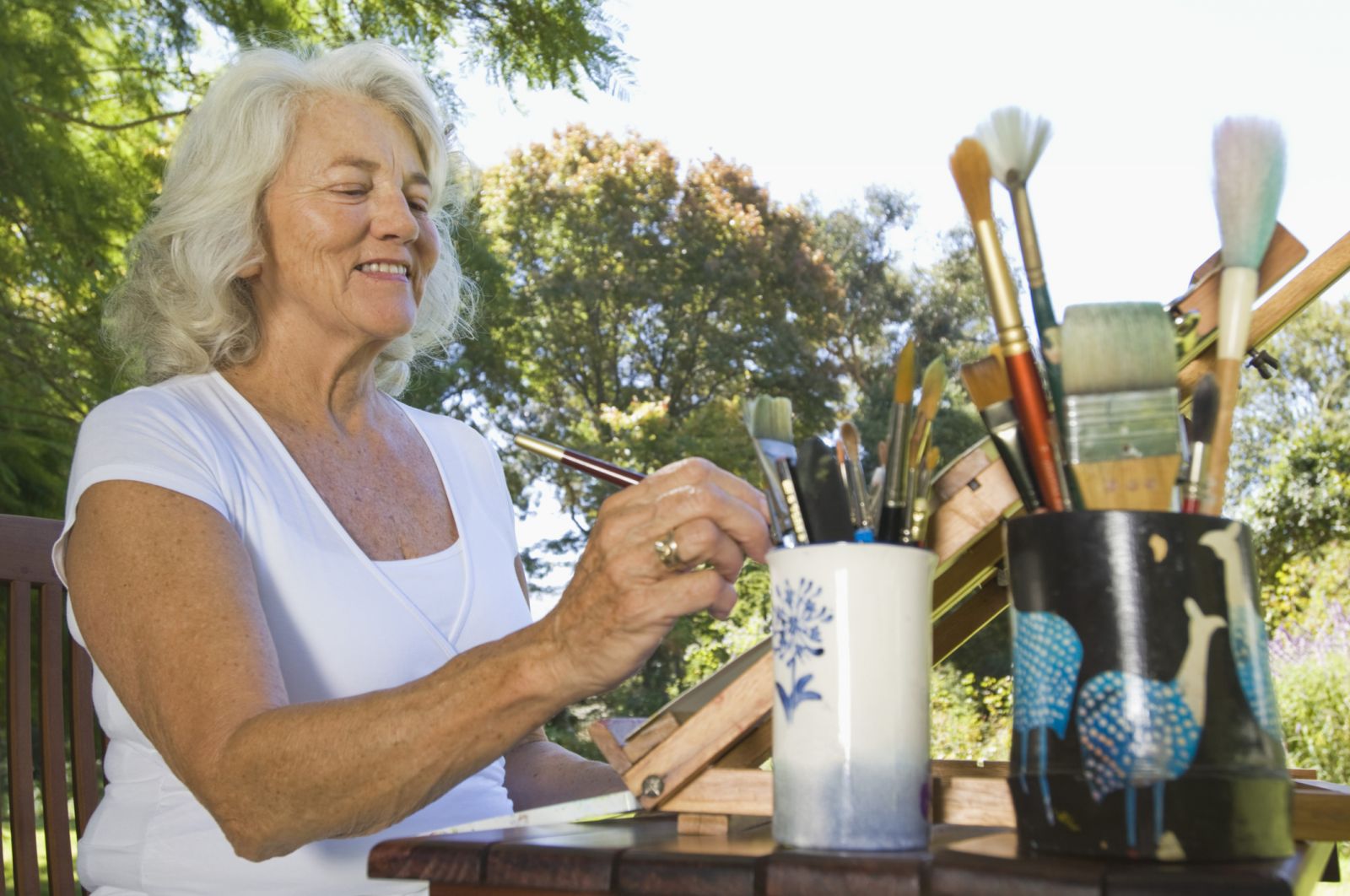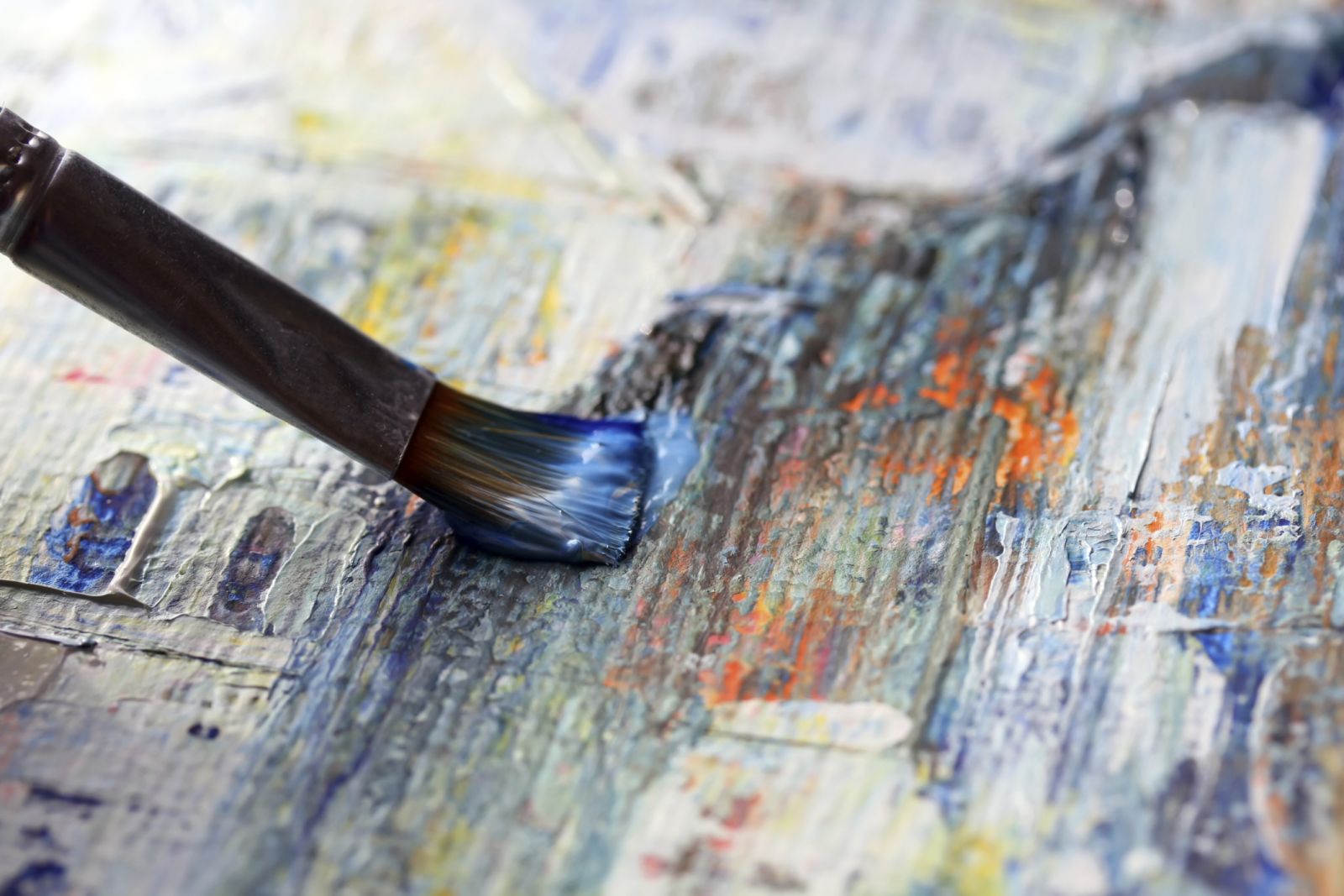Personcentered Expressive Arts Therapy Is Founded on All of the Following Notions Except
 Expressive arts therapy is a multimodal arroyo to therapy similar to its cousins drama therapy and music therapy. Expressive arts therapy may incorporate writing, drama, trip the light fantastic, movement, painting, and/or music. People utilizing expressive arts therapy are encouraged past a qualified therapist to explore their responses, reactions, and insights through pictures, sounds, explorations, and encounters with art processes. A person is not required to have artistic ability to use or benefit from expressive arts therapy.
Expressive arts therapy is a multimodal arroyo to therapy similar to its cousins drama therapy and music therapy. Expressive arts therapy may incorporate writing, drama, trip the light fantastic, movement, painting, and/or music. People utilizing expressive arts therapy are encouraged past a qualified therapist to explore their responses, reactions, and insights through pictures, sounds, explorations, and encounters with art processes. A person is not required to have artistic ability to use or benefit from expressive arts therapy.
- History of Expressive Arts Therapy
- Expressive Arts Therapy Process
- Conditions Treated with Expressive Arts Therapy
- Expressive Arts Therapy Techniques
- Expressive Arts Therapy Research
- How Art Therapy Differs from Expressive Arts Therapy
- Training for Expressive Arts Therapists
- Limitations of Limited Arts Therapy
History of Expressive Arts Therapy
Discover a Therapist
Relatively new in its formation, expressive arts therapy began circa 1970 at the Leslie Higher Graduate School in Cambridge, Massachusetts. Paolo Knill, a leader in the field, founded the International Network of Expressive Arts Therapy Training Centers and, in 1984, began the ISIS European Training Institutes. Expressive arts therapy was formed every bit a distinct practise alongside the modalities at the root of its creation. It utilizes all expressive modalities such as art, music, drama, and dance therapies. Although expressive arts therapists are non experts in all of these areas (many have multiple proficiencies), they typically possess the sensitivity and power to grasp the intermodal technique.
Expressive Arts Therapy Process
Use of the expressive arts multiplies the avenues by which a person in therapy may seek significant, clarity, and healing. It deepens and transcends traditional talk therapy by acknowledging that each person'south procedure is unique. While 1 individual may similar talk therapy, another person may prefer to utilize journaling, movement, fine art, or a combination of unlike experiences during therapy.
The accessibility of expressive arts therapy is due to the focus being not on artistic outcomes but rather on the process of creating. A person who utilizes expressive arts therapy is non required to have any artistic ability. Rather, it is through the employ of the individual's senses that the imagination can procedure, flourish, and support healing. Equally such, the process is often referred to every bit "low skill, high sensitivity."
Each creative arts modality is unique, and the utilise of each is carefully considered past each expressive arts therapist. For example, journaling might be an appropriate expressive outlet for someone new to therapy. On the other side of the spectrum, a person who has already established a strong therapeutic relationship with his or her therapist may capeesh the use of movement or drama. Conscientious use of each modality is adamant past the forcefulness, timing, pacing, and readiness of the person in therapy. Different modalities may be used at any point throughout the therapeutic process as needed. Homework may too exist issued for the person in therapy to complete betwixt sessions.
Weather Treated With Expressive Arts Therapy
Expressive arts therapy may exist used as a part of the treatment strategy for a broad variety of behavioral, emotional, and mental wellness conditions. These include:
-
 Attention-deficit hyperactivity
Attention-deficit hyperactivity - Developmental disabilities
- Eating disorders
- Traumatic brain injury
- High levels of stress
- Anxiety
- Depression
- Posttraumatic stress
- Chronic medical illnesses
- Social challenges
Expressive Arts Therapy Techniques
Many definitions of expressive arts therapy mention its use of distinct features such equally music, movement, play, psychodrama, sculpture, painting, and drawing. If necessary, though, therapists may choose to combine several techniques in social club to provide the most effective handling for the individual in therapy.
Popular therapeutic approaches may involve the apply of various drawing and fine art techniques, including:
- Finger painting
- The squiggle cartoon game (sometimes used in other therapeutic approaches, particularly with children)
- Mask making
- The blob and wet newspaper technique
- The kinetic family unit drawing technique
To illustrate, finger painting may be used equally a form of projective play wherein the therapist takes annotation of the types of lines drawn, the colors used, besides every bit the work charge per unit and rhythm of the person in handling.
In a typical session the therapist will describe the process, but will not suggest a specific topic or the colors to exist used. Instead, the therapist may provide broad instructions such equally "paint something important to you" or "paint a picture of a dream yous had." The therapist then observes the content beingness produced and the behavior of the person in therapy. Once the picture is finished, the therapist will inquire the affected individual to tell a story about the painting.
Finger painting has proven effective in the treatment of children with behavioral bug or other related mental health issues. Through consistent use of this technique, therapists may be able to learn almost a kid'southward personality traits, motor skills, and inner globe.
Expressive Arts Therapy Enquiry
The therapeutic impact of expressive arts therapy is focused on iv major areas:
- Expression
- Imagination
- Agile participation
- Listen-body connection.
Studies point that music may help individuals experiencing a broad range of social, developmental, and behavioral bug grow in self-awareness and self-confidence and larn new skills and concepts. Expressive arts therapy has also successfully helped children experiencing hyperactivity or social feet to control impulsive and ambitious behaviors. Though bear witness from empirically valid studies is express, expressive arts therapy has been used to help individuals with matted eating habits to explore issues regarding trunk epitome, cocky-esteem, social isolation, and low.
People with medical illnesses may also benefit from expressive arts therapy. Past research has studied how creating artistic photographs may assistance people cope with the distress of hospitalization. Some other study concluded elderly men and women who are part of an active choir report better health, less doc visits, fewer falls, and less medication use than peers who are not part of an organized arts program. Finally, some other body of research on children with cystic fibrosis who took part in a creative arts back up program institute the children learned how to amend express themselves, reduce stress, and discover meaning in their current health situation.
How Art Therapy Differs from Expressive Arts Therapy
Modalities such every bit art therapy, music therapy, verse therapy, dance/movement therapy, and expressive arts therapy are all examples of artistic arts therapy. While the majority of these disciplines are based in a single art modality, however, expressive arts therapy integrates therapeutic tools and techniques from many different art forms. The combination of a variety of arts-based therapeutic modalities creates a new approach which is distinct from its private components. Certified expressive arts therapists rely on their creativity and grooming in order to decide which modality should exist utilized at a detail fourth dimension. Expressive arts therapists may even employ techniques from a range of other modalities in a single therapy session.
The focus of expressive arts therapy is on the therapeutic effect of the creative experience, and it highlights the man capacity to transform thoughts, emotions, and experiences into tangible shapes and forms. The approach is described as "integrative" when different fine art techniques are intentionally used in combination with traditional medicines to promote improved health.
Training for Expressive Arts Therapists
Preparation to be an expressive arts therapist requires at least a primary'south caste in counseling with a concentration in expressive arts therapy from an accredited university. Additionally, some institutions offer document programs or studies in expressive arts for those who wish to use the expressive arts in related fields such as coaching, consulting, and educational activity. Bachelor'south and PhD options are bachelor, while certification and training continues to grow internationally.
For a list of current available resources, delight visit the International Expressive Arts Therapy Association (IEATA), which highlights graduate grooming programs, certificates, and professional development programs in expressive arts therapy. Those wishing to access this type of therapy are encouraged to notice a therapist certified in expressive arts therapy.
Limitations of Expressive Arts Therapy
Ane of the major criticisms of expressive arts therapy is the fact that the primary reason for healing is not clearly discernible. It is not clear whether healing occurs from the creative process or if it is due to positive interactions with the therapist. Every bit currently published studies tend to focus on immeasurable qualitative benefits, a lack of empirical evidence in support of the effectiveness of the approach is a business concern.
References:
- About Expressive Arts Therapy. (northward.d.). Retrieved from http://www.ieata.org/about.html
- Basso, R. & Pelech, W. (2008). Artistic arts in a children's cystic fibrosis continuing intendance plan: A canadian case study. The International Journal of Learning, 15(5).
- Frisch, Yard. J., Franko, D. L. & Herzog, D. B. (2006). Arts-based therapies in the treatment of eating disorders. Eating Disorders, fourteen, 131-142.
- Henley, D. (1999). Facilitating socialization within a therapeutic camp setting for children with attention deficits utilizing the expressive therapies. American Periodical of Art Therapy, 38.
- Improving Your Health Through the Arts. (2004, July). Wellness and Nutrition Letter of the alphabet, Tufts University.
- Stuckey, H. L. & Nobel, J. (2010). The connection between art, healing and public health: A review of current literature. American Journal of Public Health, 100(ii), 254-263.
- Trevisani, F., Casadio, R., Romagnoli, F., Zamagni, 1000. P., Francesconi, C., Tromellini, A., Di Micoli, A., Frigerio, M., Farinelli, Yard. and Bernardi, M. (2010). Art in the hospital: Its impact on the feelings and emotional state of patients admitted to an internal medicine unit. The Periodical of Alternative and Complementary Medicine, 16(viii), 853-859.
harveymandivether.blogspot.com
Source: https://www.goodtherapy.org/learn-about-therapy/types/expressive-arts-therapy
0 Response to "Personcentered Expressive Arts Therapy Is Founded on All of the Following Notions Except"
Post a Comment